Are you ready to make a splash with your canine companion? Teaching your dog to swim can be a fun and rewarding bonding experience, offering them both mental and physical stimulation. In this comprehensive guide on how to teach your dog to swim, we’ll take you through the process in eight easy steps, ensuring both you and your furry friend have a safe and enjoyable experience.
Key Takeaways
- Understand your dog’s swimming abilities and identify natural swimmers.
- Utilize appropriate safety measures, such as life jackets and monitoring water conditions for a safe experience.
- Provide positive reinforcement while gradually introducing them to deeper water, teaching entry/exit points, and expanding their activities with dock diving or paddleboarding.
Understanding Your Dog’s Swimming Abilities
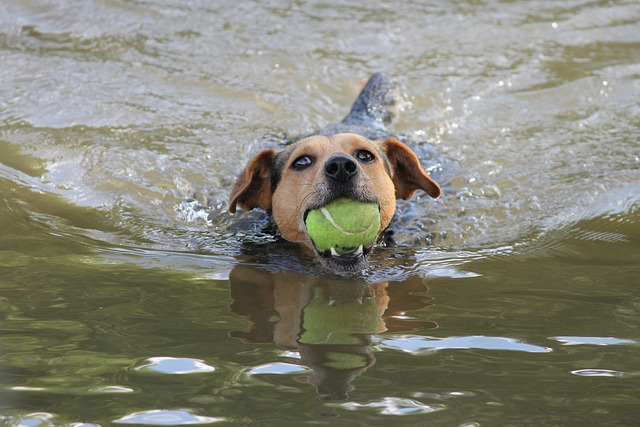
Not all dogs are born with an innate ability to swim, and some breeds may face challenges due to their body structure or weight distribution. Before venturing into the water together, familiarize yourself with your dog’s swimming capabilities.
Do you want to see if your dog can swim? It may take a little extra guidance if not.
Identifying Natural Swimmers
Some breeds, such as Portuguese Water Dogs and Labrador Retrievers, are natural swimmers due to their webbed paws and water-resistant coats. These breeds have been bred for water work, making them well-suited for aquatic adventures.
Keep in mind, that even dogs from these breeds might require guidance and support when learning to swim. Observing your dog’s movements in a natural body of water can help you assess their swimming aptitude.
Recognizing Challenges for Non-Swimmers
Certain breeds, including senior dogs, may face challenges in swimming due to their body structure or weight distribution, such as short-necked, large-chested breeds like Bulldogs. These dogs may require additional support and guidance from a certified professional dog trainer to develop their swimming skills.
Never leave your dog unsupervised near water, regardless of their swimming ability. Consider a dog’s life jacket for added safety during the learning process.
Essential Safety Precautions for Teaching Your Dog to Swim
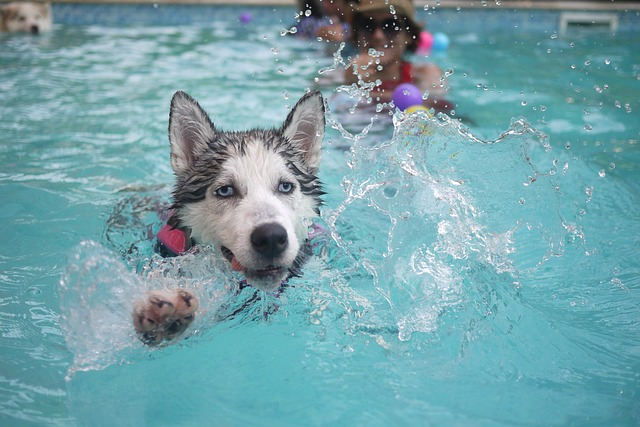
Prioritize safety when teaching your dog to swim before diving in. From selecting the right gear to monitoring water conditions, these precautions will help ensure a positive experience for both you and your pup.
Always use a life jacket designed for dogs when taking your pup out on the water. Make a Difference.
Choosing the Right Life Jacket
A life jacket plays a vital role in teaching your dog to swim, as it provides extra buoyancy, ensures visibility in the water, and gives novice swimmers added confidence.
Look for a waterproof, adjustable life jacket that fits snugly, is brightly colored for visibility, and is equipped with a handle for easy assistance. A life vest with these features will ensure your safety on the water.
Remember, a well-fitted dog life jacket can make all the difference in your dog’s swimming experience.
Monitoring Water Conditions
Monitor the water conditions during your dog’s swimming lessons. Factors to consider include water quality, temperature, potential toxic substances, waves, and currents.
Be cautious of potential hazards such as snapping turtles, water snakes, and fish hooks that may be lurking beneath the surface.
Following water safety tips will ensure a safe and enjoyable experience for both you and your dog.
Human Safety Measures
Don’t forget about your own safety during swim lessons. Wearing a life jacket not only sets a good example for your dog, but also ensures your safety in the water.
Utilize a leash or longline to maintain control of your dog and prevent them from swimming too far or getting into dangerous situations.
Gradual Introduction to Water
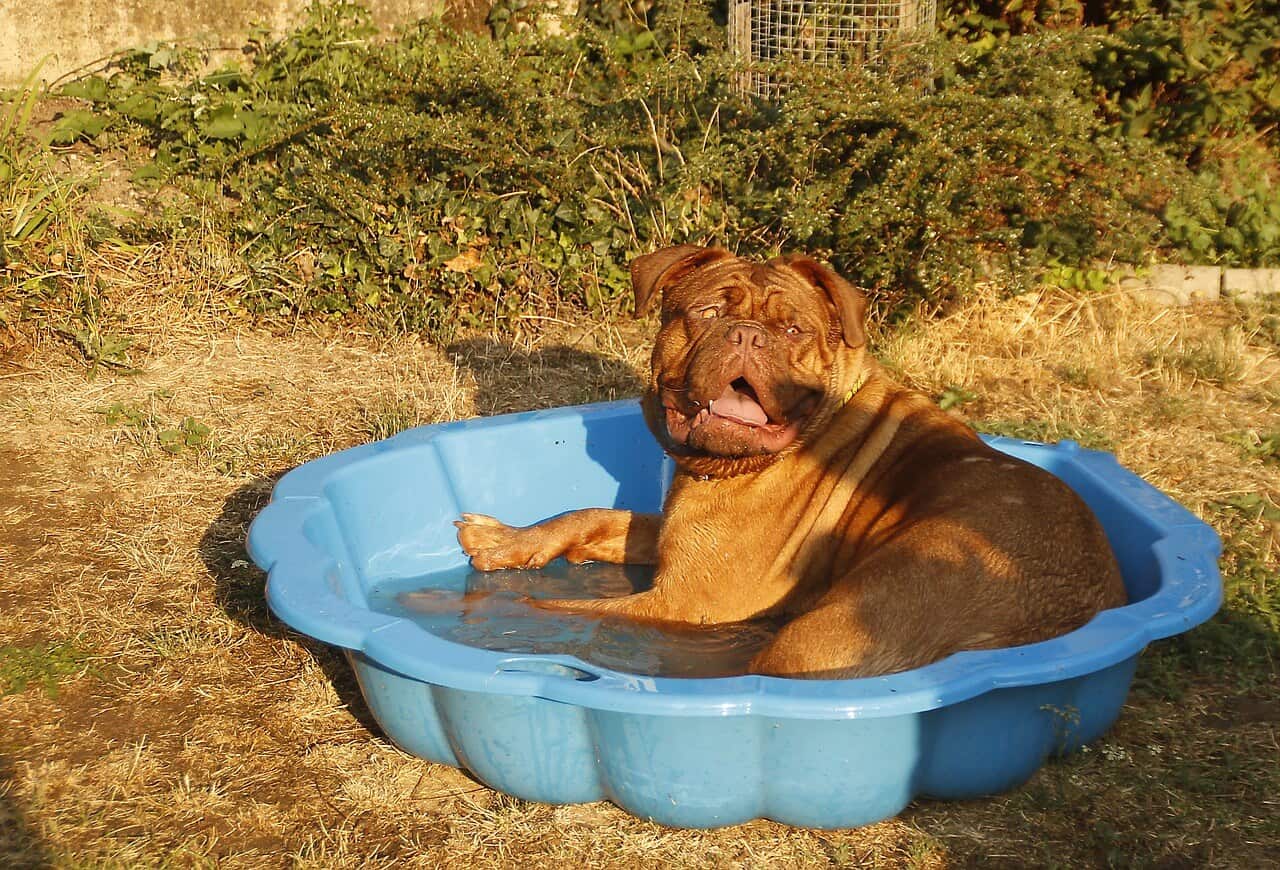
Introduce your dog to the water gradually. Begin with shallow water and use positive reinforcement techniques to help your dog feel comfortable and confident in the water.
Encourage your dog with treats and verbal praise, and be sure to take breaks if your dog is sick.
Starting with Shallow Water
Begin your dog’s swimming lessons in shallow water, such as a kiddie pool or the shallow end of a lake, allowing them to become accustomed to the sensation of being in the water. Encourage your dog to get their feet wet and gradually increase the water depth as they become more comfortable.
Remember, patience is key when introducing your dog to the water.
Using Treats and Toys as Motivation
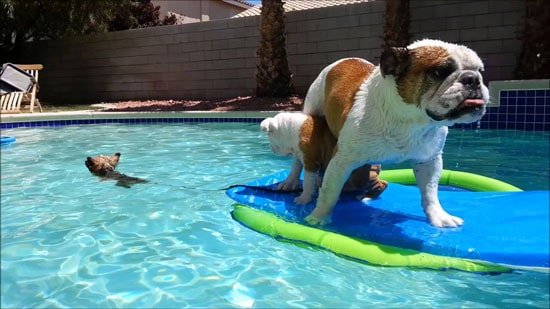
Treats and toys can motivate your dog and help them associate swimming with positive experiences. Toss a treat or toy into the water and encourage your dog to retrieve it, gradually increasing the distance and difficulty as they become more confident swimmers.
Remember to always monitor your dog and provide plenty of praise and positive reinforcement when they begin swimming lessons.
Progressing to Deeper Water
As your dog becomes more comfortable and confident in shallow water, you can gradually progress to deeper water. Ensure your dog has a solid understanding of entering and exiting the water safely before venturing into deeper areas.
Remember to be patient and allow your dog to progress at their own pace, adjusting the depth and duration of swimming sessions as they become more confident and skilled.
Building Swimming Skills
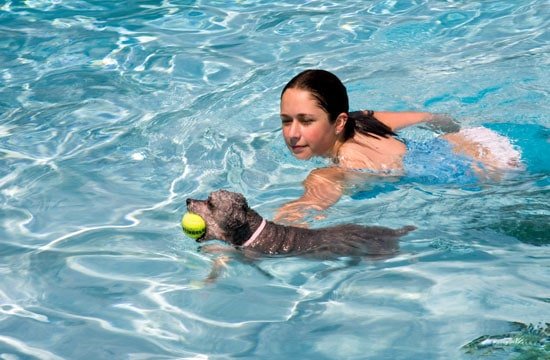
Once your dog has become comfortable in the water, it’s time to focus on building their swimming skills. Providing support and encouragement in various water environments will help your dog develop the necessary skills to become a proficient swimmer.
Supporting Your Dog in the Water
Support your dog’s body in the water to boost their confidence and facilitate proper paddling technique. Use your hands to gently support your dog under their chest, helping them maintain a horizontal position in the water.
This will encourage them to use all four legs for paddling and help maintain a balanced swimming posture.
Encouraging Proper Paddling Technique
As your dog becomes more confident in the water, focus on encouraging proper paddling technique. This includes using all four legs for paddling, maintaining a balanced swimming posture, and keeping their head above the water.
Offer praise and positive reinforcement as your dog improves their paddling technique and becomes more comfortable in the water.
Practicing in Various Water Environments
To help your dog become a versatile and adaptable swimmer, practice swimming in different water environments, such as swimming pools, lakes, and beaches. Each environment poses different challenges and will help your dog develop their swimming skills and confidence in a variety of situations.
Remember to always prioritize water safety and closely monitor your dog during swimming sessions.
Teaching Water Entry and Exit Points
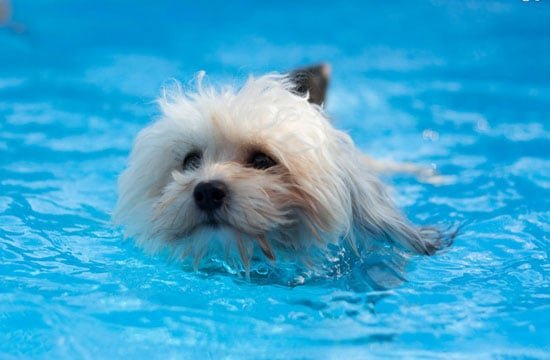
Teaching your dog to identify and use safe water entry and exit points is a critical aspect of swimming safety. This will ensure that your dog can safely enter and exit the water without becoming disoriented or putting themselves at risk.
Identifying Safe Entry and Exit Points
Show your dog where to safely enter and exit the water, such as gentle slopes or pool steps. Familiarize your dog with these entry and exit points and practice using them during your swimming sessions.
This will help your dog feel more confident and secure in the water, knowing they can easily return to dry land when needed.
Using Visual Markers
Use visual markers like flags or brightly colored tape to guide your dog to the correct entry and exit points. Placing these markers near the desired locations can help your dog easily identify and remember where to enter and exit the water.
This will further ensure your dog’s safety and confidence while swimming.
Post-Swim Care and Considerations
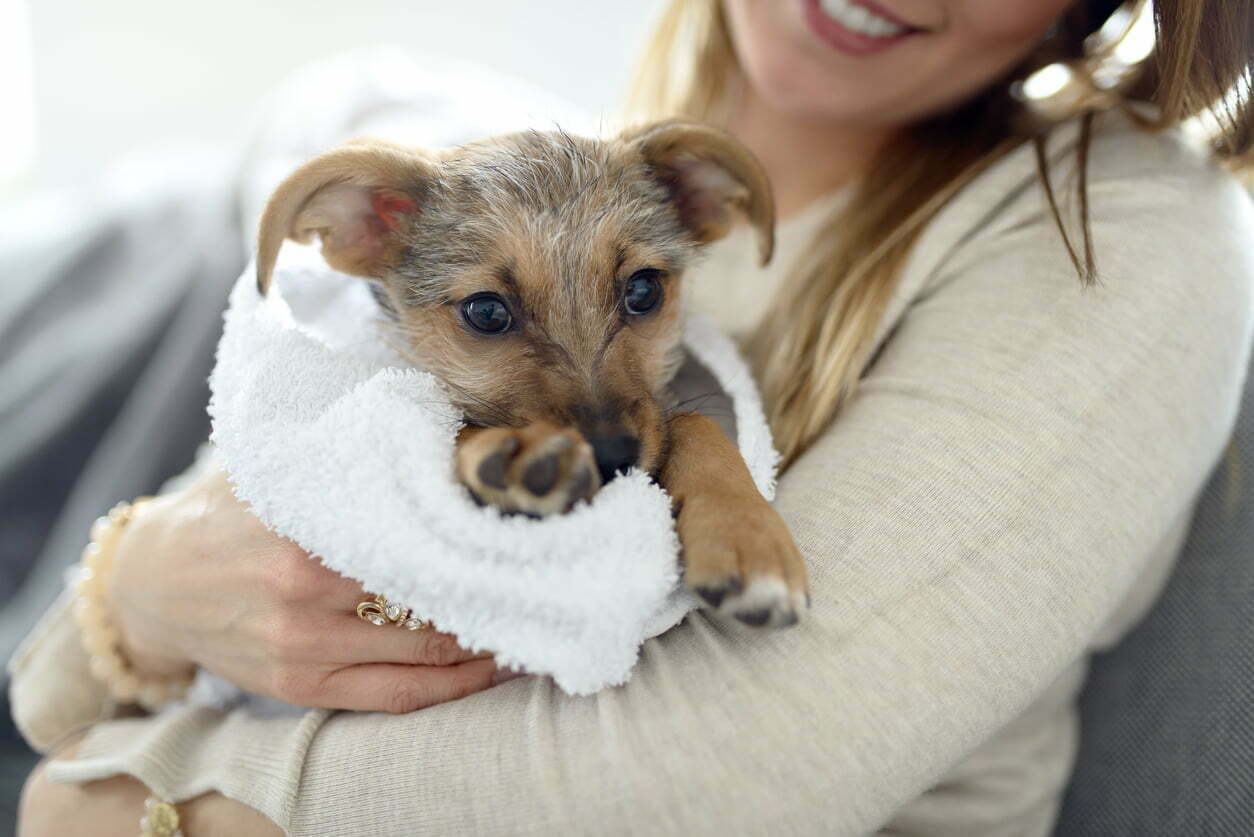
Taking care of your dog after swimming is just as important as the swim lessons themselves. From rinsing off to monitoring for signs of fatigue or discomfort, proper post-swim care will ensure your dog stays healthy and happy.
It’s important to rinse off your dog after swimming to remove any chlorine, salt, or other harmful substances.
Rinsing Off and Drying
Rinse your dog off with fresh water after their swimming session to remove any chemicals, salt, or debris they may have picked up during their swim.
Pat your dog dry with a towel, paying special attention to their ears to prevent any potential infections.
Monitoring for Signs of Fatigue or Discomfort
Keep an eye on your dog after swimming sessions for any signs of fatigue, discomfort, or health issues. If you notice your dog displaying any concerning symptoms, such as excessive panting, limping, or reluctance to move, give them a break and consult your veterinarian if necessary.
Expanding Your Dog’s Water Activities
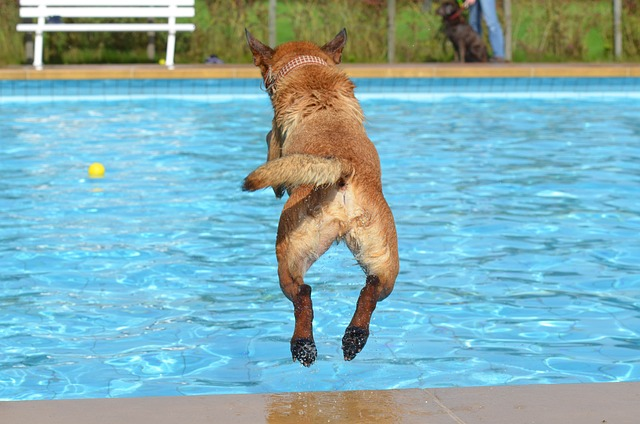
Once your dog becomes a proficient swimmer, think about expanding their water activities to include dog swim, dock diving, paddleboarding, and even dog swimming. These activities not only provide added fun and exercise, but also help your dog further develop their swimming skills and confidence, as dogs swim with enthusiasm and joy.
Dock diving is a great way to get your pup used to jumping off of a dock.
Dock Diving
Dock diving is an exciting sport where dogs leap from a stationary dock into a body of water, competing for distance or height. This activity is a great way to showcase your dog’s jumping and swimming abilities while providing them with a fun and rewarding challenge.
Remember to always prioritize safety and use a dog’s life jacket as needed during dock diving sessions.
Paddleboarding and Kayaking
For a more leisurely water activity, consider introducing your dog to paddleboarding or kayaking. These activities allow you and your dog to enjoy the water together while exploring new environments.
Remember to prioritize water safety and ensure your dog is comfortable and confident on the board or in the kayak before venturing out.
Summary
In conclusion, teaching your dog to swim can be a fun and rewarding experience for both you and your furry friend. By understanding your dog’s swimming abilities, prioritizing safety, and gradually introducing them to the water, you can help your dog become a confident and skilled swimmer. As your dog’s swimming skills improve, you can even explore new water activities such as dock diving, paddleboarding, and kayaking. So grab a life jacket, gather your treats and toys, and dive in for some splashing good fun with your canine companion!
Frequently Asked Questions
Can a dog be taught to swim?
Yes, all dogs can learn to swim with proper training and coaxing. While some may have a natural affinity for the water, others may not, but teaching them how to do so can help them feel comfortable in the pool or lake.
How do I get my dog to start swimming?
Encourage your dog to explore the water’s edge with treats, toys, or praise and gradually walk into the shallow water with them.
As they get more confident, you can then start throwing toys or treats into the deeper water and eventually your dog will start swimming.
Can a dog naturally swim?
No, not all dogs are natural swimmers. Some breeds have the physical attributes needed to swim well, while others may require life vests and swimming lessons.
Ultimately, with a little help, every breed should be able to safely get around in the water.
When should you teach your dog to swim?
You should begin teaching your dog to swim when it is two to five months old, as at that age it will have the strength and endurance necessary for its first swimming lessons.
Swimming is a great way to exercise your dog and help it stay healthy. It can also be a fun activity for both you and your pet. With the right instruction and guidance, your dog can learn to swim safely and confidently.
What safety precautions should I take when teaching my dog to swim?
Prioritize safety by selecting the appropriate gear, such as a life jacket, and monitoring water conditions.
Wear a life jacket yourself and use a leash or longline for your dog when teaching them to swim.
